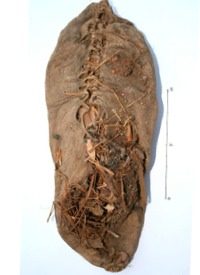
In the country of Mt. Ararat, where the Bible says Noah’s Ark rested when the Great Flood subsided, there now is news of the discovery of the world’s oldest leather shoe. First announced on the plosone.org scientific website, the moccasin-looking shoe is made of cowhide, cut into two layers, and tanned with plant or vegetable oil. A leather cord is used to lace the shoe along front and back seams through leather eyelets.
?Experts feel it probably was a right shoe and worn by a woman with about a size seven foot. The rare find was discovered in a cave, well preserved under layers of sheep dung that, along with the dry, cool atmosphere of the cave, kept both the shoe and the items found with it in excellent condition. Tests showed the shoe to be about 5,500 years old — radiocarbon-dated to about 3,500 B.C. Thus it pre-dates both Stonehenge and the Egyptian pyramids. Though compressed from use in the toe and the heel areas, it was not considered worn out. Shoes of this age are an incredibly rare find, because leather and plant materials normally degrade very quickly.
?According to The New York Times:
The Armenian shoe discovery … was made beneath one of several cave chambers, when an Armenian doctoral student, Diana Zardaryan, noticed a small pit of weeds. Reaching down, she touched two sheep horns, then an upside-down broken bowl. Under that was what felt like “an ear of a cow,” she said. “But when I took it out, I thought, ‘Oh my God, it’s a shoe.’ To find a shoe has always been my dream.”
The shoe was stuffed with grass, which scientists believe was meant to work as a shoe tree for holding the shape. It appeared to have been carefully placed in the clay-lined pit where it was found.
?Dr. Ron Pinhasi, team leader and archaeologist at the University College Cork in Ireland, was quoted as saying that the shoe resembled old Irish pampooties or “rawhide slippers.” He observed that, “As the person was wearing and lacing it, some of the eyelets had been torn and repaired.”
?The cave, also called Areni-1, was discovered in 1997. Scientists feel it was used by people with high status who, among other things, stored ritual or harvest objects of the Copper-Age, little-known Chalcolithic community there.
Until now, the oldest known closed shoes belonged to Otzi, “the Iceman,” who died around 5,300 years ago and was found in the Austrian Alps in 1991. The Armenian dig was funded in part by National Geographic, which commented:
Compared to Otzi’s shoes, the world’s oldest leather shoe is strictly bare-bones, according to Jacquie Wood, an independent archaeologist based in the U.K., who studied Otzi’s shoes and who said the new study’s science is sound.
?”The Iceman’s shoe was in another league altogether,” Wood said. “Each base was made from brown bearskin; the side panels were deerskin; and inside was a bark-string net, which pulled tight around the foot.
?”By contrast, the Armenian shoe is the most basic of shoes and was probably made worldwide once people decided not to walk about in bare feet.”
Says the PLoSOne website:
Other 4th millennium discoveries of shoes (Italian and Swiss Alps), and sandals (Southern Israel) indicate that more than one type of footwear existed during the 4th millennium BC, and that we should expect to discover more regional variations in the manufacturing and style of shoes where preservation conditions permit.
In our age of popular old world-style footwear — think of the ancient Greek and Roman sandal fashions now in vogue — those awaiting these further discoveries must especially include 21st century shoe designers who are in search of fresh inspiration.
?It all just goes to show, nihil sub sole novum— especially in affairs of the feet.
Photo of oldest shoe: AP Images



